Every summer, I start a vegetable garden. I purchase seeds, plant them in various places in my backyard, tend to them, and with the help of the right weather conditions, help them grow. Why am I talking about gardening on a marketing blog?
Content seeding. But instead of planting zucchini seeds, marketers plant content to grow brand awareness and leads.
Let's get into the specifics of what content seeding is and how it works.
Content seeding allows brands to highlight their content in places target audiences will see and engage with it. Influencers are a prime choice for content seeding because they usually have large audiences. These audiences have been proven to trust influencers more than their friends.
For instance, lifestyle subscription box FabFitFun has a target audience of women "ages 18-34, who love a good deal [and] want to hear about the latest and greatest trends in beauty, fitness, nutrition, and style." When they work with influencers on content seeding, they choose platforms their target audience is interested in, like my favorite podcast, True Crime Obsessed (TCO).
When I heard ads for FabFitFun on TCO, I was immediately interested in the brand and what it offers, so I followed the link in the podcast subscription. The added bonus of hearing high praises from hosts I've come to connect with and trust solidified my interest and ultimately drove me to subscribe. That's content seeding in motion.
When I heard ads for FabFitFun on TCO, I was immediately interested in the brand and what it offers, so I followed the link in the podcast subscription. The added bonus of hearing high praises from hosts I've come to connect with and trust solidified my interest and ultimately drove me to subscribe. That's content seeding in motion.
Part of the reason content seeding is so successful is that the content shared by influencers or partners is relevant to the target audience. Market research shows brands, like FabFitFun, where their audience is and gives them clues as to where to seed content.
What is influencer seeding?
Often brands will give out products or services to influencers in the hopes that they will share favorable reviews or promote the product to their audience. This is referred to as influencer seeding. Like content seeding, utilizing influencers that align with the interests of your target audience will yield the best results.
Having industry leaders promote a brand through their social platforms or other networks increases the reach of the business, because they've built trust with their own audiences.
This doesn’t mean that you have to find the influencer with the most followers to do the job. Sure, someone with millions of followers will have a wide reach, but there is value in utilizing micro-influencers, too. Micro-influencers – those with roughly 10,000 to 50,000 followers – often serve more niche, but loyal audiences. This can be an advantage when you are looking to segment or narrow your target audience.
Micro-influencers also provide a level of authenticity influencers with higher follower counts lack due to their mass appeal. Social media platforms are inundated with marketing campaigns and ads. Make your product or service stand out by tapping into the networks of smaller influencers and take advantage of word-of-mouth cred.
However, influencers aren't the only way to facilitate content seeding. You can also contact an agency that specializes in seeding, or reach out to thought leaders for a partnership on a blog post or email newsletter.
Where Content Seeding is Commonly Used
While blogging and editorial outlets previously served as the primary avenues for content seeding, social media platforms have become the dominant method of choice.
- TikTok
- YouTube
- Podcasts
All of these platforms are useless if you don’t have a plan in place to utilize them. Next, we’ll dig into tips for creating an effective influencer seeding campaign.
Creating an Influencer Seeding Strategy
Creating a plan will help you conserve resources and focus your energy on what’s most important for your brand. Here are some best practices to follow:
- Set your end goal: What would you like to accomplish? Are you looking to build brand awareness or boost sales? Once your goals are established, you can assess which platform would make the most sense to use to achieve them.
- Research ideal influencers: By now you should have clear personas identifying who your target audience is. With that information in hand, look into the types of people they would follow and their interests. Look at trending hashtags or topics related to your brand, and the influencers who follow them.
- Send relevant content, services, and products: You’ll want to make sure what you’re sending the influencer to promote is actually relevant to their brand and audience. For example, if you sell artisan chocolates, you may want to reach out to influencers that have content dedicated to chocolate sweets and desserts, instead of just sending products out to foodies in general. This is where going niche pays off.
- Engage and comment: If an influencer posts anything regarding your brand, engage with it. This can include liking the post, commenting, or sharing. Even if the feedback is negative, you can thank them for their honest review and find out how you can make improvements.
- Measure the outcome: Examine the reach of influencer posts, traffic statistics, and engagement (shares, comments, brand mentions). For ecommerce, track any promo codes or affiliate links used during the campaign. Looking at these metrics will help you figure out what worked and what didn’t.
If you're starting to think of ways you can get into content seeding, which platforms to use, and what content to share — don't worry, we're going to look at more great examples of content seeding next.
Content Seeding Examples
1. Claire Saffitz x Coveteur
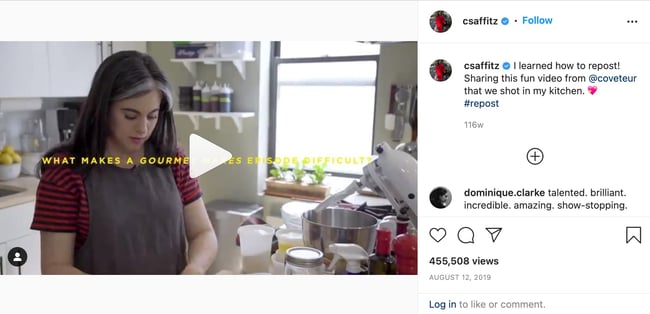
Claire Saffitz, host of series "Gourmet Makes," has become a food influencer because of how much she connects with fans of the channel. Recently, Saffitz collaborated with magazine Coveteur on her Instagram.
This is a great example of content seeding because Coveteur's partnership with Saffitz brought recognition to their magazine. Her Q/A with the lifestyle magazine could closely appeal to Saffitz's fans: people who are interested in cooking and health. The closely running avenues of the publisher’s audiences mean a potential 971,000 new readers from Saffitz's Instagram.
2. Mandy McEwen x LinkedIn Marketing
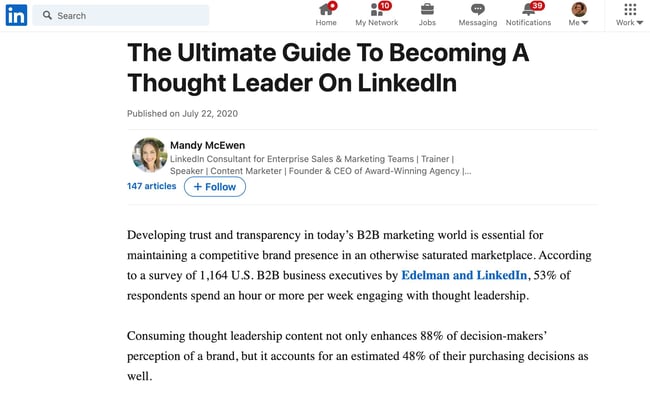
Founder of marketing company Mod Girl Marketing, Mandy McEwen, partnered with LinkedIn Marketing's Thought Leadership campaign. This partnership aligns with McEwen's following — professionals who are interested in working with thought leaders — and LinkedIn's audience — professionals looking for workplace connections and advancements.
McEwen also gains new engagement from the partnership, while building her credibility as a marketer. This is a great example of how content seeding can work both ways to build brand awareness.
3. Lin-Manuel Miranda x Reddit
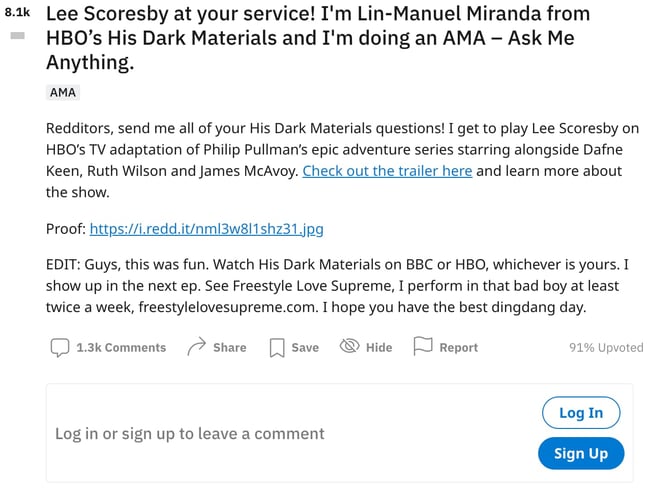
Social platform Reddit had actor Lin-Manuel Miranda (Hamilton, In the Heights) run an Ask Me Anything (AMA) on the site. The thing about AMAs is that you must have an account to participate. Fans had to sign up for an account to ask Miranda a question, then notice social communities for Miranda's line of work, like Broadway and television.
Having Miranda post this on Twitter to three million followers is great exposure for Reddit. If the platform wanted to grow its theatre-based threads and community, this AMA was a perfect seed to plant.
4. Louis Tomlinson x GQ
Musician Louis Tomlinson collaborated with GQ to go undercover, answering comments from Twitter, YouTube, and Instagram. The Actually Me series not only gets celebrities to answer fun questions, but it’s a great way for them to engage directly with fans.
Tomlinson and GQ each have large audiences, but Tomlinson’s 35 million Twitter followers and 17.9 million Instagram followers would certainly expand GQ’s reach.
GQ partnering with Tomlinson to promote another channel of theirs is a smart way to attract potential subscribers. If fans find that more of their favorite artists have similar videos on GQ’s YouTube channel, they might tune in and share their finds to their own audience.
5. Sara Blakely x Masterclass
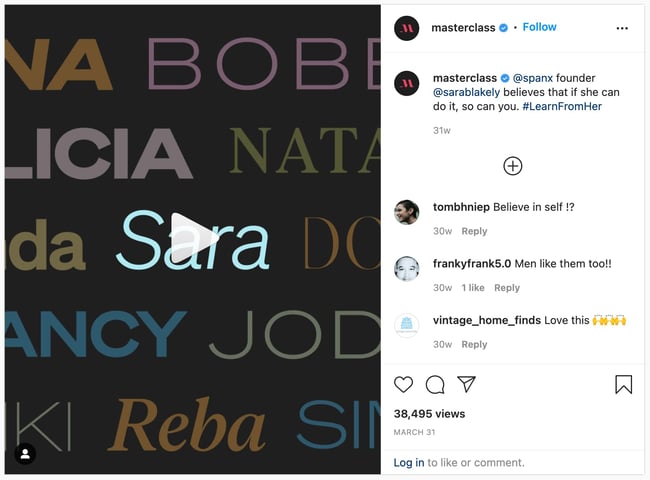
Founder and CEO of Spanx, Sara Blakely, worked with MasterClass on an entrepreneurship course. MasterClass is an online education platform offering courses in various industries. Learn tennis from 23-time title holder Serena Williams or get a crash course in fashion from Vogue Editor-In-Chief Anna Wintour.
Blakely's partnership with MasterClass is an invitation for fans of the entrepreneur to get a look into how she built her empire. If 300,000 of Blakely's followers are interested in her story, the website could benefit greatly from dropping their branded content on her Instagram.
Make Content Seeding Work for You
My vegetable garden thrives every year because of a combination of work from my end, the right soil, and favorable weather conditions. The same is true for content seeding. A perfect content seeding strategy is built from a combination of brands finding the right partners, a great platform, and a favorable product or service to promote.
You don't have to invest huge amounts of money into content seeding. Choosing micro-influencers or guest bloggers and podcast interviews are more cost-effective ways of content seeding as well.
This article was originally published November 25, 2019 and has been updated for comprehensiveness.
from Marketing https://blog.hubspot.com/marketing/content-seeding
Every summer, I start a vegetable garden. I purchase seeds, plant them in various places in my backyard, tend to them, and with the help of the right weather conditions, help them grow. Why am I talking about gardening on a marketing blog?
Content seeding. But instead of planting zucchini seeds, marketers plant content to grow brand awareness and leads.
Let's get into the specifics of what content seeding is and how it works.
Content seeding allows brands to highlight their content in places target audiences will see and engage with it. Influencers are a prime choice for content seeding because they usually have large audiences. These audiences have been proven to trust influencers more than their friends.
For instance, lifestyle subscription box FabFitFun has a target audience of women "ages 18-34, who love a good deal [and] want to hear about the latest and greatest trends in beauty, fitness, nutrition, and style." When they work with influencers on content seeding, they choose platforms their target audience is interested in, like my favorite podcast, True Crime Obsessed (TCO).
When I heard ads for FabFitFun on TCO, I was immediately interested in the brand and what it offers, so I followed the link in the podcast subscription. The added bonus of hearing high praises from hosts I've come to connect with and trust solidified my interest and ultimately drove me to subscribe. That's content seeding in motion.
When I heard ads for FabFitFun on TCO, I was immediately interested in the brand and what it offers, so I followed the link in the podcast subscription. The added bonus of hearing high praises from hosts I've come to connect with and trust solidified my interest and ultimately drove me to subscribe. That's content seeding in motion.
Part of the reason content seeding is so successful is that the content shared by influencers or partners is relevant to the target audience. Market research shows brands, like FabFitFun, where their audience is and gives them clues as to where to seed content.
What is influencer seeding?
Often brands will give out products or services to influencers in the hopes that they will share favorable reviews or promote the product to their audience. This is referred to as influencer seeding. Like content seeding, utilizing influencers that align with the interests of your target audience will yield the best results.
Having industry leaders promote a brand through their social platforms or other networks increases the reach of the business, because they've built trust with their own audiences.
This doesn’t mean that you have to find the influencer with the most followers to do the job. Sure, someone with millions of followers will have a wide reach, but there is value in utilizing micro-influencers, too. Micro-influencers – those with roughly 10,000 to 50,000 followers – often serve more niche, but loyal audiences. This can be an advantage when you are looking to segment or narrow your target audience.
Micro-influencers also provide a level of authenticity influencers with higher follower counts lack due to their mass appeal. Social media platforms are inundated with marketing campaigns and ads. Make your product or service stand out by tapping into the networks of smaller influencers and take advantage of word-of-mouth cred.
However, influencers aren't the only way to facilitate content seeding. You can also contact an agency that specializes in seeding, or reach out to thought leaders for a partnership on a blog post or email newsletter.
Where Content Seeding is Commonly Used
While blogging and editorial outlets previously served as the primary avenues for content seeding, social media platforms have become the dominant method of choice.
- TikTok
- YouTube
- Podcasts
All of these platforms are useless if you don’t have a plan in place to utilize them. Next, we’ll dig into tips for creating an effective influencer seeding campaign.
Creating an Influencer Seeding Strategy
Creating a plan will help you conserve resources and focus your energy on what’s most important for your brand. Here are some best practices to follow:
- Set your end goal: What would you like to accomplish? Are you looking to build brand awareness or boost sales? Once your goals are established, you can assess which platform would make the most sense to use to achieve them.
- Research ideal influencers: By now you should have clear personas identifying who your target audience is. With that information in hand, look into the types of people they would follow and their interests. Look at trending hashtags or topics related to your brand, and the influencers who follow them.
- Send relevant content, services, and products: You’ll want to make sure what you’re sending the influencer to promote is actually relevant to their brand and audience. For example, if you sell artisan chocolates, you may want to reach out to influencers that have content dedicated to chocolate sweets and desserts, instead of just sending products out to foodies in general. This is where going niche pays off.
- Engage and comment: If an influencer posts anything regarding your brand, engage with it. This can include liking the post, commenting, or sharing. Even if the feedback is negative, you can thank them for their honest review and find out how you can make improvements.
- Measure the outcome: Examine the reach of influencer posts, traffic statistics, and engagement (shares, comments, brand mentions). For ecommerce, track any promo codes or affiliate links used during the campaign. Looking at these metrics will help you figure out what worked and what didn’t.
If you're starting to think of ways you can get into content seeding, which platforms to use, and what content to share — don't worry, we're going to look at more great examples of content seeding next.
Content Seeding Examples
1. Claire Saffitz x Coveteur

Claire Saffitz, host of series "Gourmet Makes," has become a food influencer because of how much she connects with fans of the channel. Recently, Saffitz collaborated with magazine Coveteur on her Instagram.
This is a great example of content seeding because Coveteur's partnership with Saffitz brought recognition to their magazine. Her Q/A with the lifestyle magazine could closely appeal to Saffitz's fans: people who are interested in cooking and health. The closely running avenues of the publisher’s audiences mean a potential 971,000 new readers from Saffitz's Instagram.
2. Mandy McEwen x LinkedIn Marketing

Founder of marketing company Mod Girl Marketing, Mandy McEwen, partnered with LinkedIn Marketing's Thought Leadership campaign. This partnership aligns with McEwen's following — professionals who are interested in working with thought leaders — and LinkedIn's audience — professionals looking for workplace connections and advancements.
McEwen also gains new engagement from the partnership, while building her credibility as a marketer. This is a great example of how content seeding can work both ways to build brand awareness.
3. Lin-Manuel Miranda x Reddit

Social platform Reddit had actor Lin-Manuel Miranda (Hamilton, In the Heights) run an Ask Me Anything (AMA) on the site. The thing about AMAs is that you must have an account to participate. Fans had to sign up for an account to ask Miranda a question, then notice social communities for Miranda's line of work, like Broadway and television.
Having Miranda post this on Twitter to three million followers is great exposure for Reddit. If the platform wanted to grow its theatre-based threads and community, this AMA was a perfect seed to plant.
4. Louis Tomlinson x GQ
Musician Louis Tomlinson collaborated with GQ to go undercover, answering comments from Twitter, YouTube, and Instagram. The Actually Me series not only gets celebrities to answer fun questions, but it’s a great way for them to engage directly with fans.
Tomlinson and GQ each have large audiences, but Tomlinson’s 35 million Twitter followers and 17.9 million Instagram followers would certainly expand GQ’s reach.
GQ partnering with Tomlinson to promote another channel of theirs is a smart way to attract potential subscribers. If fans find that more of their favorite artists have similar videos on GQ’s YouTube channel, they might tune in and share their finds to their own audience.
5. Sara Blakely x Masterclass

Founder and CEO of Spanx, Sara Blakely, worked with MasterClass on an entrepreneurship course. MasterClass is an online education platform offering courses in various industries. Learn tennis from 23-time title holder Serena Williams or get a crash course in fashion from Vogue Editor-In-Chief Anna Wintour.
Blakely's partnership with MasterClass is an invitation for fans of the entrepreneur to get a look into how she built her empire. If 300,000 of Blakely's followers are interested in her story, the website could benefit greatly from dropping their branded content on her Instagram.
Make Content Seeding Work for You
My vegetable garden thrives every year because of a combination of work from my end, the right soil, and favorable weather conditions. The same is true for content seeding. A perfect content seeding strategy is built from a combination of brands finding the right partners, a great platform, and a favorable product or service to promote.
You don't have to invest huge amounts of money into content seeding. Choosing micro-influencers or guest bloggers and podcast interviews are more cost-effective ways of content seeding as well.
This article was originally published November 25, 2019 and has been updated for comprehensiveness.

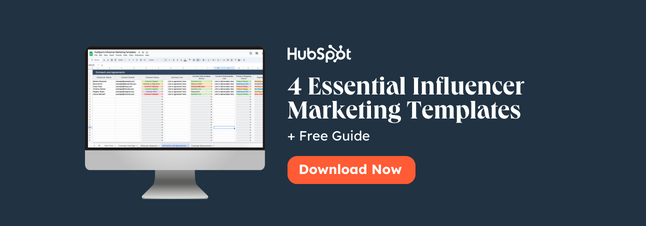
No hay comentarios:
Publicar un comentario